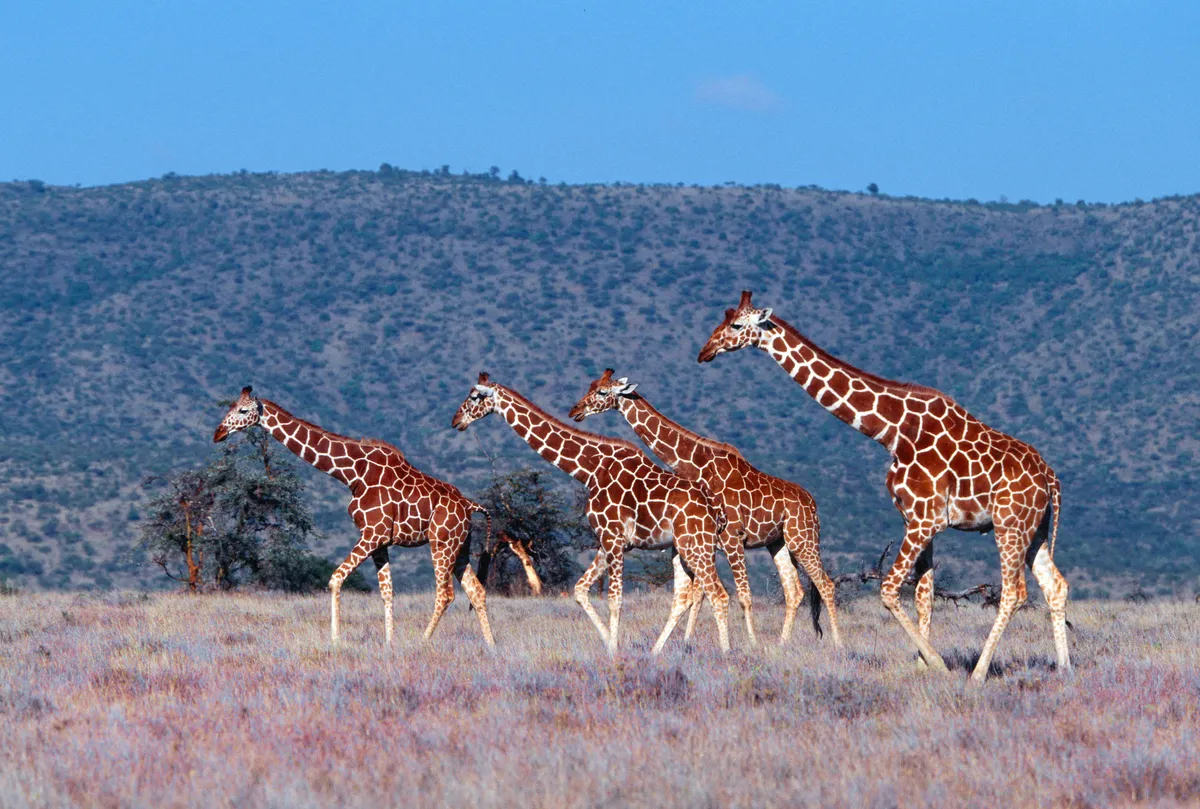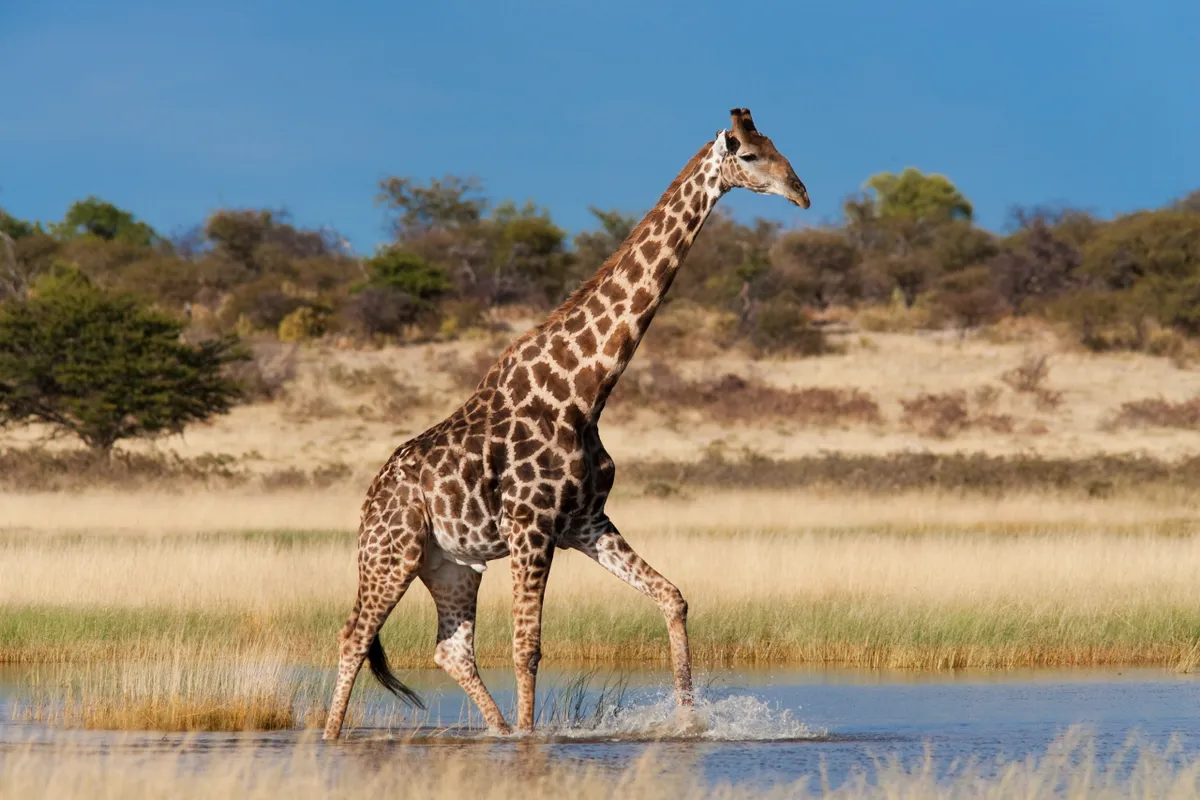In our expert guide by the Giraffe Conservation Foundation, learn all about these impressively tall mammals, including key species facts, their diet and best places to see them in their natural habitat.
What type of mammal is a giraffe?
The giraffe is an African even-toed ungulates and the world's tallest living terrestrial animal. Some other even-toed ungulates include, hippopotamuses, deer, goats, camels, cattle, antelopes and sheep.
How many species of giraffe are there?
A study published in Current Biology in 2016 suggests that the giraffe is not a single species, but a subfamily containing four distinct species - the northern giraffe (Giraffa camelopardalis), southern giraffe (Giraffa giraffa), reticulated giraffe (Giraffa reticulata) and Masai giraffe (Giraffa tippelskirchi).
To make this groundbreaking discovery, the team examined DNA taken from skin biopsies of 190 giraffes collected across Africa. This sampling included populations from all nine previously recognised giraffe subspecies, which may now be spread across four separate species.
The differences in each group’s genetic composition suggest that there’s little crossover between the various species, which implies that they must have evolved separately.
How tall is a giraffe?
The giraffe is the tallest mammal in the world, standing at around 4-5m high, and the tallest giraffes ever recorded have been up to 5.9m. That’s over a meter higher than a double-decker bus. It shouldn't come as a huge surprise that such a large animal weighs quite a lot as well - up to 1900kg, which is more than most cars!

One of our favourite giraffe facts is that they're probably the biggest pollinators in the world thanks to their great height. As they wander around feeding from the tops of trees, they inadvertently transfer genetic material on their muzzles from the flowers of one tree to those of another.
How many bones do giraffes have in their necks?
Despite being incredibly tall, giraffes still only have seven vertebrae in their necks - which means a giraffe neck has the exact same number of bones as a human neck!

How does a giraffe drink?
With difficulty! A giraffe’s neck is too short to reach the ground. As a result, it has to awkwardly shuffle and spread its front legs to reach the ground for a drink of water. Fortunately giraffes only need to drink once every few days, as they can get most of their water from all the plants they eat.

What do giraffes eat?
Giraffes mostly eat fresh leaves and twigs from the tops of trees (particularly spiky acacia trees) where other browsing species can't reach them. That means giraffes can afford to be pickier than most big animals, and they're also better able to cope with droughts than smaller animals, as the tallest trees tend to have the deepest roots that reach down to water that other trees can't access.

But you might be more surprised to discover that the seemingly gentle giraffe also eats bones. Giraffes aren't predators, so they don't kill other animals, but their huge skeletons require more calcium and phosphorous than they can get from a strictly vegetarian diet. The easy solution is to chew the bones from carcasses to make their own bones stronger, a behaviour known as osteophagy.
What noise does a giraffe make?
It was previously thought that giraffes are quiet animals that don't make a noise, however research now suggests that giraffes in fact hum mostly at night, with the occasional snort or grunt.
How do giraffes give birth?
Giraffes occasionally sit or lie down, but not for long. They do most things standing up, including sleeping, mating and giving birth. After a gestation lasting around 450 days, one of the longest of any hoofed animal, a female giraffe drops her calf – literally. The 100kg baby falls around 2m to the ground, snapping its umbilical cord.
Sometimes the mother bends her hindlegs slightly to help, but it’s still a brutal plunge. Amazingly, the infant is unharmed and will be on its legs and suckling within the hour. It stands over 1.6m tall – tall enough to reach mum’s teats.
This Q&A originally appeared in BBC Wildlife Magazine, and was answered by Ben Hoare.
What is a baby giraffe called - and how do they stand so quickly after birth?

A baby giraffe is called a calf and incredibly it has the ability to stand, with the odd wobble, soon after being born. It is thought the long gestation period of a giraffe – 15 months – helps the calf become more developed so it can stand and walk at a very early age.
Please note that external videos may contain ads:
Will a giraffe faint if it stands up too quickly?
A fully grown giraffe can raise or lower its head by up to 5m, so it might actually pass out were it not for a dense network of fine capillaries (the ‘rete mirabile’) that cushions its brain against rapid changes in blood pressure.
Other adaptations to prevent sudden giraffe collapse are valves to stop the back-flow of blood and elastic-walled vessels that dilate and constrict to manage flow. NASA has even done research on the blood vessels in giraffe legs to get inspiration for human space suits.

Are giraffes endangered?
Current giraffe numbers mean the IUCN classifies the animals as a species of ‘least concern’. But if the results of the study above lead to the total giraffe population being split between four species, the adjustment could lead to one or more of them being classified as species under threat.

Where do giraffes live?
The natural habitat for giraffes used to be distributed throughout North and West Africa, including the Sahara, and along the Nile. However, today giraffes are only found in sub-Sarahan Africa.
How did giraffes evolve?
Surprisingly enough for an African species, the giraffe originated from Eurasia, probably temperate Eurasia. This genus evolved seven to eight million years ago.

Are any other animals related to giraffes?
The giraffe genus (Giraffa) is part of the Giraffidae family, which contains only one other species: the rare okapi, the closest relative of the giraffe. This forest-dweller has a shorter neck, just like the extinct species from which both it and giraffes are thought to have evolved.
While the okapi's black-and-white hind stripes might make you think of zebras, the resemblance is purely coincidental.
Okapi - a relative of the giraffe
Okapi are the only living relative of the giraffe. Both are in the Giraffidae family, with girafffes in the Giraffa genus and okapi in the Okapia genus.
Giraffidae are ruminants, and share a common ancestor with deer and bovids. On first sight, the two Giraffidae look quite different but do share a number of similar features, including a long, dark-coloured tongue.
In the okapi, the tongue can measure between 14 and 18 inches long and they can lick their own ears and eyelids.
What is a group of giraffes called?
Quite aptly, a group of giraffes is called a 'tower'. Giraffes are also called a herd of giraffes.
Do giraffes walk like horses?
Unlike most other four-legged mammals like horses, giraffes swing both legs on the same side at almost the same time during their walk, known as ‘pacing’. Camels walk in the same way, and you'll feel the sideways motion if you ever ride one.
When a giraffe breaks into a gallop, its odd walk disappears and it runs in a more 'normal' way.
How big are a giraffe's hooves?
Giraffe feet are the size of a dinner plate with a diameter of 30cm. These huge hooves prevent giraffes from sinking into loose sand despite their great weight.

Can giraffes swim?
Until recently it was widely assumed that a giraffe’s long, spindly legs would not provide sufficient purchase in water to support its neck, and that the proportion of its elongated extremities to its short body would reduce buoyancy.
Therefore the giraffe was supposedly the only mammal in the world that could not swim (indeed, the authoritative Handbook of the Mammals of the World states bluntly that it cannot).

But this is probably wrong. A 2010 study in the Journal of Theoretical Biology used a complex digital model to prove that the average adult giraffe would, in fact, become buoyant in 2.8m of water.
Admittedly its heavy front legs would tip the animal forward, so to keep its head clear it would need to crank its neck backwards at an awkward angle, while the legs, swept to the rear, would have limited power.
So a giraffe could theoretically swim, but it would almost certainly never choose to, and it would be pretty terrible at it anyway.
How does a giraffe swim?
If you're wondering how you would even go about testing the bouyancy of a giraffe without a very large swimming pool or even a giraffe, have a read of this explanation by one of the study's authors:
N.B. Both links here go to external sites.
Image from Henderson & Naish (2010)
What's the point of giraffe horns?
Both male and female giraffes have ‘horns’ at birth. More properly known as 'ossicones', they lie flat and are not attached to the skull to avoid injury at birth. They only fuse with the skull later in life.
Giraffe horns become formidable weapons in adult males, worn bare of skin at the tips – old bulls may even have patches of bare bone elsewhere on their massive, craggy heads.

Does each giraffe have a unique pattern?
Just like human fingerprints, no two giraffes have the same pattern. Researchers who spend long enough studying the same giraffes eventually find that they can recognise dozens or even hundreds of individuals from their patterns.

How do giraffes cope with high temperatures?
It's thought that the pattern on a giraffe doesn't just serve to camouflage the animal, but also helps with temperature regulation too. The coloured skin patches can act to dissipate heat around the body, as the temperature of the skin is slightly higher in darker regions, facilitating the dilation of vessels beneath the skin's surface.
Giraffes also have an efficient nasal cooling system to regulate brain temperature up to 3°C lower than the rest of the body.
How long is a giraffe's tongue?
Giraffe tongues are huge! They're bluish-purple, prehensile and between 45-50cm long - perfect for carefully ripping fresh leaves from between the spikes at the top of acacia trees.

Do giraffes fight?
When fighting, male giraffes will push and shove against each other. This occasionally escalates into powerful blows delivered by their muscular necks. The loser can be knocked out, and sometimes even killed.
Please note that external videos may contain ads:
How big is a giraffe's heart?
A giraffe heart can weigh approximately 11kg, making it the biggest of any land mammal. It can pump 60 litres of blood around its body every minute at a blood pressure twice that of an average human.

How long do giraffes live?
Giraffes in the wild tend to live between 20 to 25 years.
Find out more about the Giraffe Conservation Foundation
